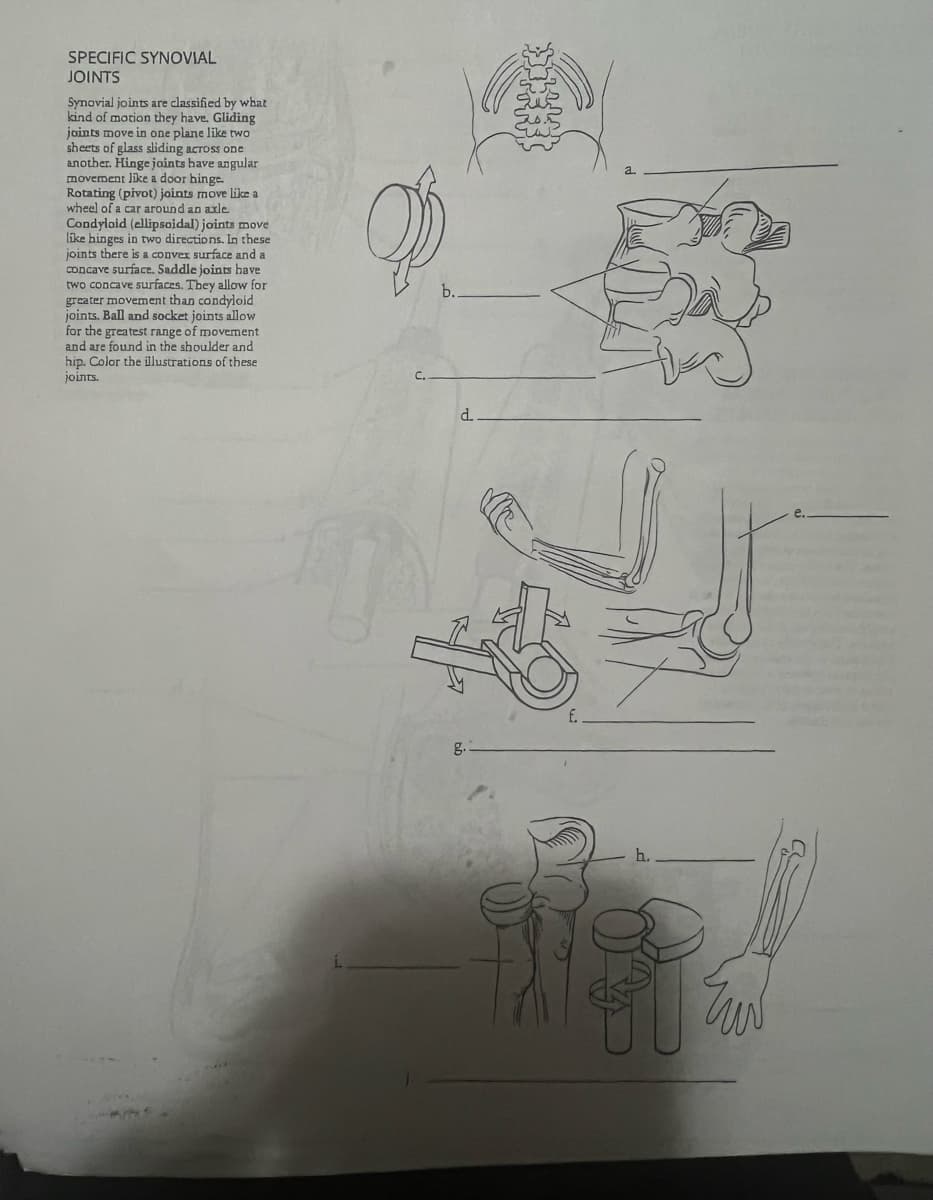SPECIFIC SYNOVIAL JOINTS Synovial joints are classified by what kind of motion they have. Gliding joints move in one plane like two sheets of glass sliding across one another. Hinge joints have angular movement like a door hinge. Rotating (pivot) joints move like a wheel of a car around an axle. Condyloid (ellipsoidal) joints move like hinges in two directions. In these joints there is a convex surface and a concave surface. Saddle joints have two concave surfaces. They allow for greater movement than condyloid joints. Ball and socket joints allow for the greatest range of movement and are found in the shoulder and hip. Color the illustrations of these joints.
SPECIFIC SYNOVIAL JOINTS Synovial joints are classified by what kind of motion they have. Gliding joints move in one plane like two sheets of glass sliding across one another. Hinge joints have angular movement like a door hinge. Rotating (pivot) joints move like a wheel of a car around an axle. Condyloid (ellipsoidal) joints move like hinges in two directions. In these joints there is a convex surface and a concave surface. Saddle joints have two concave surfaces. They allow for greater movement than condyloid joints. Ball and socket joints allow for the greatest range of movement and are found in the shoulder and hip. Color the illustrations of these joints.
Human Anatomy & Physiology (11th Edition)
11th Edition
ISBN:9780134580999
Author:Elaine N. Marieb, Katja N. Hoehn
Publisher:Elaine N. Marieb, Katja N. Hoehn
Chapter1: The Human Body: An Orientation
Section: Chapter Questions
Problem 1RQ: The correct sequence of levels forming the structural hierarchy is A. (a) organ, organ system,...
Related questions
Question
Can you fill the blank spaces from a to j

Transcribed Image Text:SPECIFIC SYNOVIAL
JOINTS
Synovial joints are classified by what
kind of motion they have. Gliding
joints move in one plane like two
sheets of glass sliding across one
another. Hinge joints have angular
movement like a door hinge.
Rotating (pivot) joints move like a
wheel of a car around an axle.
Condyloid (ellipsoidal) joints move
like hinges in two directions. In these
joints there is a convex surface and a
concave surface. Saddle joints have
two concave surfaces. They allow for
greater movement than condyloid
joints. Ball and socket joints allow
for the greatest range of movement
and are found in the shoulder and
hip. Color the illustrations of these
joints.
C.
b..
d
g.
f.
a.
h.
Expert Solution
This question has been solved!
Explore an expertly crafted, step-by-step solution for a thorough understanding of key concepts.
Step by step
Solved in 3 steps with 3 images

Recommended textbooks for you

Human Anatomy & Physiology (11th Edition)
Anatomy and Physiology
ISBN:
9780134580999
Author:
Elaine N. Marieb, Katja N. Hoehn
Publisher:
PEARSON

Anatomy & Physiology
Anatomy and Physiology
ISBN:
9781259398629
Author:
McKinley, Michael P., O'loughlin, Valerie Dean, Bidle, Theresa Stouter
Publisher:
Mcgraw Hill Education,

Human Anatomy
Anatomy and Physiology
ISBN:
9780135168059
Author:
Marieb, Elaine Nicpon, Brady, Patricia, Mallatt, Jon
Publisher:
Pearson Education, Inc.,

Human Anatomy & Physiology (11th Edition)
Anatomy and Physiology
ISBN:
9780134580999
Author:
Elaine N. Marieb, Katja N. Hoehn
Publisher:
PEARSON

Anatomy & Physiology
Anatomy and Physiology
ISBN:
9781259398629
Author:
McKinley, Michael P., O'loughlin, Valerie Dean, Bidle, Theresa Stouter
Publisher:
Mcgraw Hill Education,

Human Anatomy
Anatomy and Physiology
ISBN:
9780135168059
Author:
Marieb, Elaine Nicpon, Brady, Patricia, Mallatt, Jon
Publisher:
Pearson Education, Inc.,

Anatomy & Physiology: An Integrative Approach
Anatomy and Physiology
ISBN:
9780078024283
Author:
Michael McKinley Dr., Valerie O'Loughlin, Theresa Bidle
Publisher:
McGraw-Hill Education

Human Anatomy & Physiology (Marieb, Human Anatomy…
Anatomy and Physiology
ISBN:
9780321927040
Author:
Elaine N. Marieb, Katja Hoehn
Publisher:
PEARSON